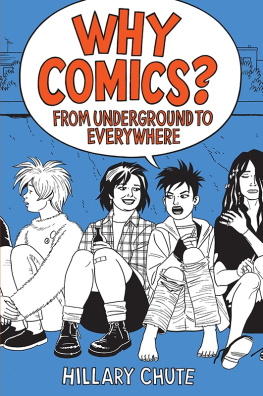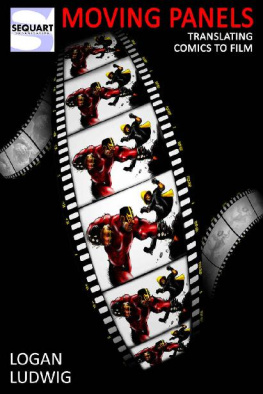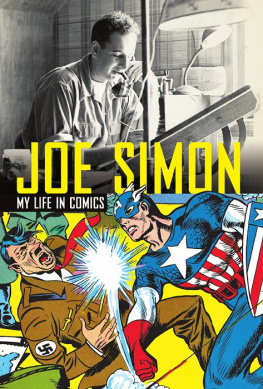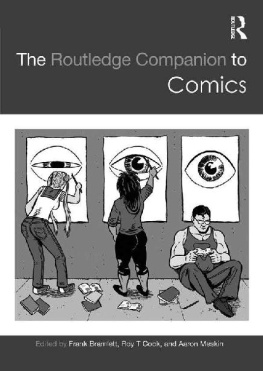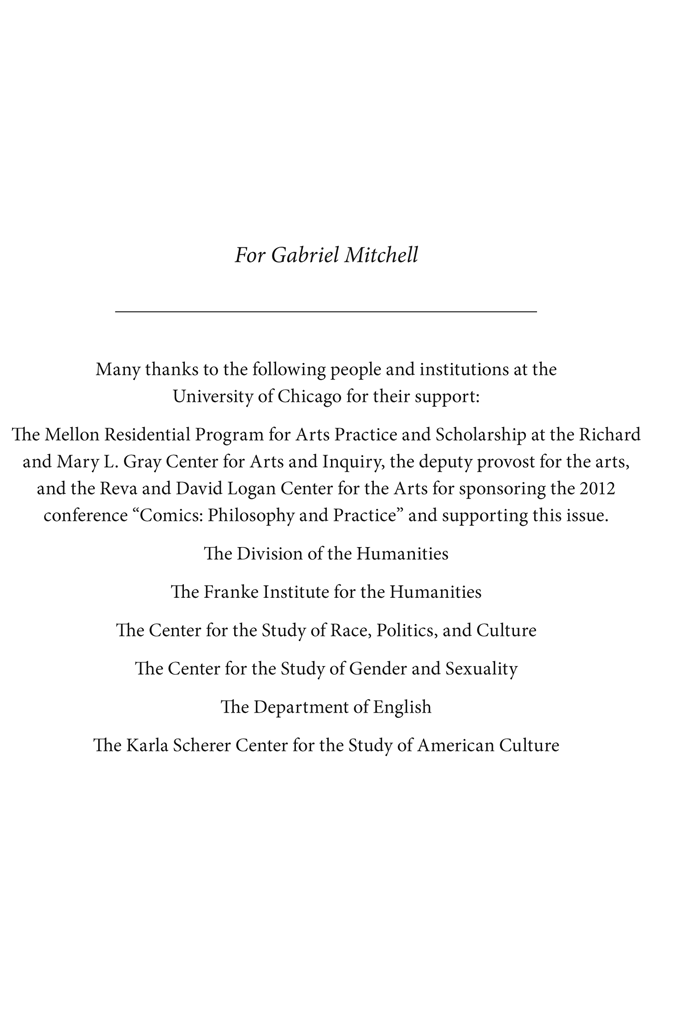Critical Inquiry
Spring 2014
Special Issue of Critical Inquiry
Comics & Media
Edited by Hillary Chute and Patrick Jagoda
Hillary Chute and Patrick Jagoda
Lynda Barry
W.J.T. Mitchell and Art Spiegelman
Tom Gunning
Hillary Chute and Alison Bechdel
Chris Ware
Joe Sacco and W.J.T. Mitchell
Yuri Tsivian
Franoise Mouly
Phoebe Gloeckner, Justin Green, Aline Kominsky-Crumb, and Carol Tyler
Scott Bukatman
Aline Kominsky-Crumb and Kristen Schilt
Aline Kominsky-Crumb
Daria Khitrova
Justin Green
Charles Burns, Daniel Clowes, Seth, and Chris Ware
Seth
Katalin Orbn
Phoebe Gloeckner
Franoise Mouly, Daniel Clowes, R. Crumb, and Chris Ware
Garland Martin Taylor
Alison Bechdel and Hillary Chute
N. Katherine Hayles, Patrick Jagoda, and Patrick LeMieux
Lynda Barry, Ivan Brunetti, R. Crumb, and Gary Panter
W. J. T. Mitchell
Carol Tyler
On the cover: R. Crumb, rejected The New Yorker cover (2009).
Front and back endpapers: Seth, sketches of conference participants.
Critical Inquiry 40 (Spring 2014): 110
Special Issue: Comics & Media
Hillary Chute and Patrick Jagoda
Introduction
Why does it make sense for a professor who specializes in what we might think of as the old media form of comics (with its instantiation, in the US, in newsprint) and one who specializes in new media studies (with an emphasis on digital forms) to collaborate on a special issue of Critical Inquiry? Although seemingly at opposite endsat least judging by the different materiality of the objects that generate our researchof a spectrum in literary studies and in the humanities generally, we have found numerous opportunities to collaborate. (We have worked together since we began teaching, each at slightly obverse angles to the English department, at the University of Chicago in 2010.) It is not only that the medium of comics, like new media texts from electronic literature to video games, includes both words and images or that both smack of newfound respectability, at least in the context of academia. It is rather that comics and new media so often enable an intense focus on how complexly woven stories unfold across time and space and, particularly, how these involve the reader (or viewer, or player) to generate meaning through interacting with, or themselves shaping, spatiotemporal form. Across all of the different kinds of work, scholarly and artistic, included in this issue, we see attention to the ludic engagement produced by a range of forms both old and new. The included pieces also attend to embodied activity, not only the work of the hand of the creator, but also the embodied activity of reading, looking, and playing, whether in relation to the printed page, the stage, or the screenand the spaces among them.
The Comics & Media special issue is inspired by the May 2012 Comics: Philosophy and Practice conference at the University of Chicago, which here provides a springboard for an exploration of media histories with their numerous continuitiesand divergences. Organized by Hillary Chute (under the auspices of the Mellon Residential Program for Arts Practice and Scholarship at the University of Chicagos Richard & Mary L. Gray Center for Arts and Inquiry), the conference offered three days of public conversations, talks, and panels featuring seventeen of todays most acclaimed cartoonists: Lynda Barry, Alison Bechdel, Ivan Brunetti, Charles Burns, Daniel Clowes, Robert Crumb, Phoebe Gloeckner, Justin Green, Ben Katchor, Aline Kominsky-Crumb, Franoise Mouly, Gary Panter, Joe Sacco, Seth, Art Spiegelman, Carol Tyler, and Chris Ware. This special issue archives the events of that historic gathering of cartoonists and also takes them as a starting point to amplifythrough critical essays, transcripts, and original artwork from conference participantsissues that the conference highlighted about producing and consuming media as an embodied activity, about time, space, play, print culture, and also what we might think of as the reemergence of the handwritten form of comics in todays media landscape. As its title indicates, the conference aimed to create generative exchange between arts practice and critical and theoretical practice. The original artwork and the critical essays themselves produce a cross-media conversation in this issue. And just as the cartoonists at the conference expressed, again and again, meticulous attention to the materiality comics instantiates, Comics & Media expresses its own commitment to the physical object by publishing at a larger size (7 x 10) and in full color throughout, which distinguishes it from any other issue in the history of Critical Inquiry.
Comics & Media considers a range of mediascapes: the objects of its critical essays include film, ballet, vernacular Russian print (lubok), transmedia games, comics, sculpture, panorama, and hypertext. Examining ballet alongside games alongside comics, the question for us is: how do these forms inform each other and, through their constellation, promote a robust comparative media studies? These forms raise a number of aesthetic and philosophical inquiries into how artistic forms in general generate movement and stillness (on their surfaces and within their audiences), how they enable different forms of play, and how we experience and apprehend media in relation to each other. This issue balances three essays exploring different media forms that make up a transhistorical media triptych (Yuri Tsivian, Daria Khitrova, and Patrick Jagoda, N. Katherine Hayles, and Patrick LeMieux), with three essays that take comics as a central point of inquiry and reveal their commitments by situating the form within various media ecologies (Tom Gunning, Scott Bukatman, and Katalin Orbn). Further, this issue instantiates in its own material form the dynamic view of media its essays index, interspersing the essays with comics art by ten contemporary cartoonists (Barry, Bechdel, Gloeckner, Green, Kominsky-Crumb, Mouly, Seth, Spiegelman, Tyler, Ware), eight illustrated conference transcripts, and a sampling of images from Henry Jackson Lewis (18371891), an artist who was born into slavery and has been called the first African American cartoonistalong with, online, an exclusive hub from the transmedia game Speculation.
We are less interested in emphasizing multimedia forms than we are in transmedia relationsboth historical and currently unfoldingamong ostensibly discrete and evidently imbricated or impure forms. We seek to explore past histories of a form and also point to experimentation with emerging hybrid forms. In this way, comics and transmedia games, both of which absorb and reconfigure the potentials of other available forms and media in different ways, serve as historical and formal bookends to this issue.
Evident from the prominent space opened up to practicing artists and original visual work, the intertwining of theory and practice is significant to the shape of this issue and our view of how to practice contemporary media studies. As we began to imagine this issue, we had back-to-back teaching and research collaborations with artistsChute with cartoonist Bechdel, Jagoda with new media artist Sha Xin Weithrough the Gray Center for Arts and Inquiry, which enabled us to work within forms like comics and transmedia games, thinking through their properties and constraints from the inside-out as well as the outside-in. Collaboration, as our work together on this issue suggests, is a critical component of the transmedia ecologies and approaches that we track. Collaboration has, in recent years, thrived in the emergent digital humanities and new media studies. The benefits of such collaboration should not, however, be limited to digitally oriented fields. Areas such as comics, film, and game studies reward thick comparative analyses that benefit from multiauthor projects and extended dialogues. The comics conference, for instance, was the result of an oncampus collaboration with Bechdel, who taught Lines of Transmission: Comics and Autobiography with Chute in Spring 2012; they continue their collaboration here in the short comics piece Bartheses.


